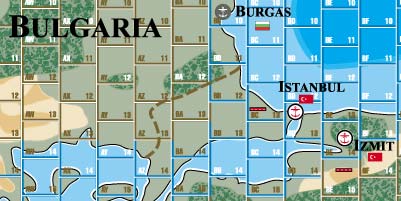For three years, Britain and Italy struggled for control
of the Mediterranean Basin. While the Italian Navy tried
to keep the sea lanes open from north to south, the British
fought to do the same on the east-west route. Air, surface
and submarine battles were inevitable.
The Italians had courage, nearby bases and a tremendous
shortage of fuel. The British had courage, more ships
and aircraft and the secret to the German code machine.
Eventually these factors won out and Italy changed sides,
joining the Allies to help overthrow the Nazi regime.


Bomb Alley takes the Second World War at
Sea series to this important theater with fifty scenarios. There are 280 “long”
playing pieces, depicting the major fleet units of both
sides: battleships, aircraft carriers, cruisers and fleet
destroyers. There are also 560 square playing pieces,
half the size of the ship pieces, mostly depicting aircraft
but also smaller warships and markers.
Italy receives all her ships and aircraft of 1940 through
1942: from the mighty battleship Vittorio Veneto to the
aircraft carrier Aquila on down to the gallant torpedo boat Lupo.
The famous Italian aircraft are here: the SM.79 Sparviero
torpedo bomber, the nearly worthless Cr.42 biplane fighter
and the excellent Mc.202 fighter plane. 

The Royal Navy has battleships like Malaya and
Warspite, aircraft carriers like Formidable
and a bevy of cruisers and destroyers. British aircraft
are usually better than those available to the Italians.
Neither side has complete control over their air forces:
There are many planes in the theater, but most of them
are assigned to other tasks. When the players call for
them, they may not arrive. This adds an element of uncertainty
into the game, and ensures that the same scenario never
plays the same way twice.
With 50 scenarios from which to choose, there is a wide
variety of action available. There are the valiant convoy
defenses of both sides, such as Operation Pedestal. Battleship
clashes like Cape Teulada or the Italian disaster at Cape
Matapan. Carrier raids like Taranto. Impossible fights
against terrible odds, such as the night battle in which
the Italian torpedo boat Lupo took on and defeated
three British cruisers.
In addition to Britain and Italy, ships and aircraft make an appearance
from France, the United States, Greece, Poland, the Soviet Union, Romania,
Germany, Australia and the Netherlands. There’s even a German helicopter
carrier (with helicopter)!

The operational map depicts the enter Mediterranean Basin,
including all the major ports and airbases of 1940-42.
The tactical map is a generic blue field of hexagons,
used to resolve surface combat. There, ships maneuver
and fight using their gunnery and torpedo factors. Each
player rolls a number of dice according to the ship’s
capabilities, hitting on a result of 6. Gunnery and torpedo
damage tables give the results: Ships can suffer damage
to engines, hull or armament.


Air attacks are resolved in similar fashion. The combat
systems yield results rapidly but in a historically accurate
fashion, giving a good balance of fun and insight.
 Links: Links:
STK #0017
Status: Gone forever.
|
